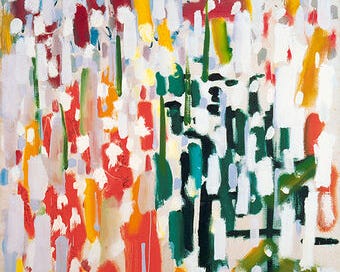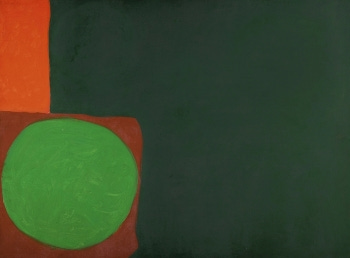Hi, before I get started I wanted to let you know about my new Substack that’s coming soon. It’s all about my own art, and how/why I make it. If you fancy following along, please subscribe.
Patrick Heron (1920-1999) stands as one of the most significant figures in British art, renowned for his vibrant contributions to modernist painting. His work, characterized by its vivid colour, abstract forms, and innovative spatial dynamics, marked him as a key player in the post-war British art scene. Heron's artistic journey is not merely a narrative of individual creativity but also a testament to the broader movements and cultural shifts that defined the 20th century.
Early Life and Influences
Born in Leeds, England, Patrick Heron was immersed in an environment that fostered his artistic inclinations from an early age. His father, T.M. Heron, was a notable figure in the textile industry and an avid art collector, which exposed Patrick to modern art from a young age. This early exposure laid the foundation for his lifelong fascination with colour and form.
Heron's formal education at the Slade School of Fine Art in London, albeit brief due to the interruption of World War II, was crucial in shaping his artistic approach. The wartime years saw Heron working as an agricultural laborer and later as a textile designer, experiences that would profoundly influence his understanding of colour and pattern. His post-war years were marked by an intense engagement with the avant-garde, drawing inspiration from French artists like Henri Matisse and Pierre Bonnard, whose emphasis on color would become a hallmark of Heron's work.
Evolution of Style
Patrick Heron's early works exhibit a strong figural quality, but as he matured, his style evolved towards greater abstraction. The 1950s were a transformative decade for Heron, as he began to embrace pure abstraction. His move to Cornwall in 1956 marked a pivotal point in his career. The Cornish landscape, with its unique light and colour, deeply influenced his palette and compositional style.
Heron's work during this period is characterized by bold, flat planes of colour and an exploration of spatial relationships. Paintings such as "Azalea Garden: May 1956" showcase his ability to create dynamic compositions through the juxtaposition of vivid hues. His use of color was not merely decorative but a means of expressing spatial depth and emotional resonance.
Contribution to Modernism
Heron's significance in the modernist movement extends beyond his canvas. As an influential art critic, he wrote extensively for publications like The New English Weekly and The New Statesman, championing contemporary art and advocating for the recognition of British artists. His writings reflect a deep understanding of the theoretical underpinnings of modernism and a passionate commitment to its principles.
Heron's role as a teacher further solidified his impact on the British art scene. He taught at the Central School of Arts and Crafts in London and later at the Royal Academy Schools, influencing a generation of young artists. His emphasis on the primacy of color and form resonated with his students, many of whom carried forward his modernist legacy.
Legacy and Impact
Patrick Heron's legacy is firmly rooted in his unwavering commitment to the exploration of colour and abstraction. His works are held in major collections worldwide, including the Tate Gallery in London and the Museum of Modern Art in New York, testifying to his enduring influence.
In the broader context of art history, Heron's contribution lies in his ability to synthesize the European modernist tradition with a distinctly British sensibility. His paintings reflect a harmonious balance between the rational and the emotive, the structured and the spontaneous. Heron's art invites viewers into a world where colour is not merely seen but felt, where the boundaries of form are continually reimagined.
Patrick Heron remains a towering figure in 20th-century art, whose work continues to inspire and challenge. His journey from the figural to the abstract mirrors the broader evolution of modernist art, while his dedication to colour and form underscores the enduring power of visual expression. As we reflect on Heron's legacy, we are reminded of the profound capacity of art to transform perception and evoke the inexpressible.









Doesn’t seem like art to me. If you have to explain why it’s good, it’s likely not.